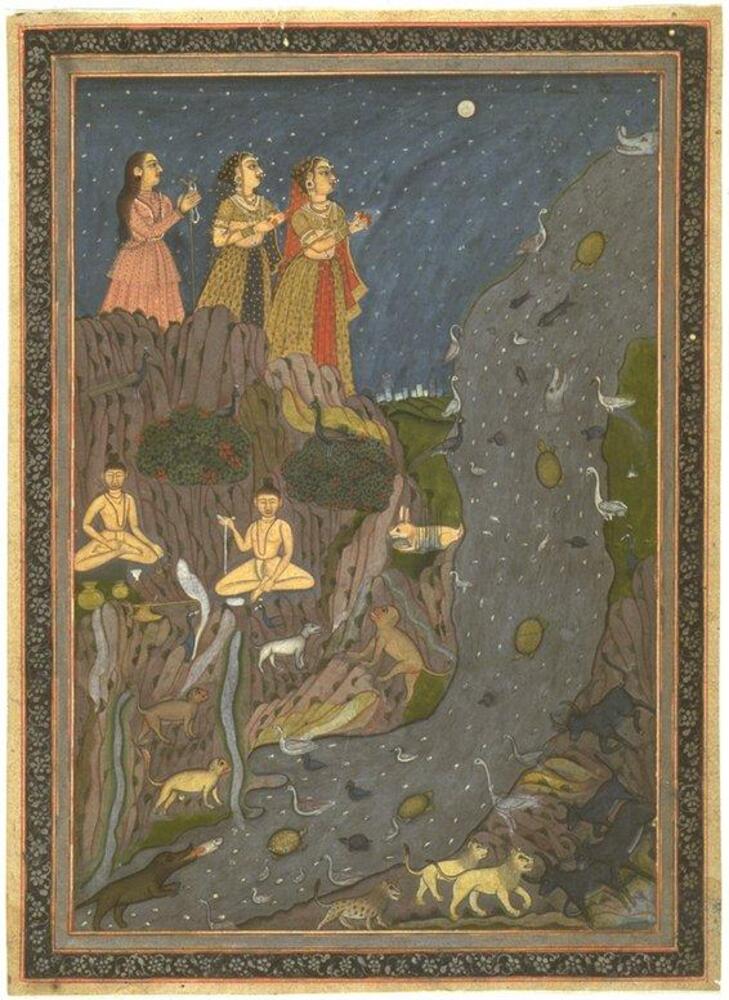Essay: The Descent of the River Ganges
This Painting, The Descent of the Ganges, painted about 1775, is from an area in central India called Bundelkhand, now included in northern Madhya Pradesh state.
The Mughal (from the Persian and Arabic mugul, from Mongolian Mongul) empire in India was at the height of its power at the beginning of the 17th century. The Mughal Empire was an Islamic empire within India, and lasted from 1526–1857. The dynasty was founded by Babur, the Turkic great grandson of Tamerlane and descended on his mother’s side from Genghis Khan. Babar’s grandson, Akbar is conventionally described as the glory of the empire (r. 1556-1605). Just at the end of Akbar’s life, in 1600, the British chartered the East India Company, authorizing it to conduct trade.
At Akbar’s death, Jahangir (r. 1605-1627) assumes the throne and he and his wife set a tone of courtly elegance combining Indian and Persian cultures. Shah Jahan (r. 1627-58), who commissioned the Taj Mahal, succeeds Jahangir. In 1658 Aurangzeb, third son of Shah Jahan, and an orthodox Sunni, usurps the throne. He reverses many of his predecessors’ conciliatory moves toward the Hindu population. The combination of Mughal—strongly influenced by Persian—and various regional Indian aesthetics, mark the art of the 17th and 18th centuries in India.
Many of the works surviving this period are illustrated texts painted in watercolor with gold. A heavy Persian/Mughal influence is evident, particularly in the flat profiles of the faces and the generally monochrome backgrounds. The close observation of nature and sensitive rendering of animals are hallmarks of Mughal painting.
The Ganges is the sacred river of India. It is referred to as “Ma Ganga” (Mother Ganges) by many Hindus. The river is said to cleanse devotees of Hinduism of sin, and many people bathe in it as a form of ritual purification. Even to have three drops of its water placed on the forehead will purify the believer. The Ganges is worshipped as a goddess, under the name Gangesdeva, and to say the name of Gangesdeva while bathing in the river is a sure way to get to heaven. Many people also deposit the ashes of loved ones in the waters of the river for the same reason.
UMMA’s painting references a myth about the sacred river. The below label details the story:
According to an ancient legend, the goddess Ganga (the personification of the River Ganges) once dwelt in heaven, and the earth suffered from drought. Through the prayers of Bhagiratha, the gods agreed to allow Ganga to descend to earth, but that brought about another crisis: if Ganga were to fall unimpeded, the force of the mighty river could destroy the earth. Bhagiratha then performed penances to seek the aid of the powerful Hindu god Shiva, who responded by catching Ganga in his densely matted locks of hair to break her fall.
In this intensely lyrical painting from Bundelkhand in Central India, the great river is shown tumbling from the night sky. Ascetics sit cross-legged on the mountainside, offering their austerities to Shiva, while women come to venerate Ganga. The river teems with life—crocodiles, turtles, fish, and birds—while lions, leopards, jackals, monkeys, and rabbits cavort on its banks. It is as if Ganga has restored life to the entire world. (Label Copy from "Divine Encounters, Earthly Pleasures: Twenty Centuries of Indian Art," (December 12, 2003 – February 22, 2004).
The Mughal period was a rich time artistically and produced many paintings like this one. The complex subject matter and formal innovations are distinctive hallmarks of the aesthetic, and make paintings like this one stand out.
Themes and Ideas for Teaching
How does the painting exhibit the stylistic characteristics of the Mughal aesthetic?
How does this painting describe the Hindu idea of death and afterlife?
Department of Islamic Art. "The Art of the Mughals after 1600". In Timeline of Art History. New York: The Metropolitan Museum of Art, 2000–. http://www.metmuseum.org/toah/hd/mugh/hd_mugh.htm (October 2002)
“Styles of Indian Painting,” from online exhibition based on Worlds of Wonder and Desire: Indian Paintings from the Virginia Museum of Fine Arts, Virginia Museum of Fine Arts, November 21, 2001 through February 24, 2002, http://www.vmfa.museum/worlds/worlds_styles.html
“Primary Colors: Paintings from 17th-Century Central India and 18th-Century Nepal” Philadelphia Museum of Art, May 13, 2004 - October 11, 2004, http://www.philamuseum.org/exhibitions/2004/126.html
Created For
K-12 EducatorK-12 Student
Museum Visitor
UMMA Docent
UMMA Staff
University Faculty
University Student
Rate this Resource
AVG: 0 | Ratings: 0
& Author Notes
Creative Commons by-nc-saLast Updated
May 1, 2018 10:28 a.m.Report
Reporting Policy

